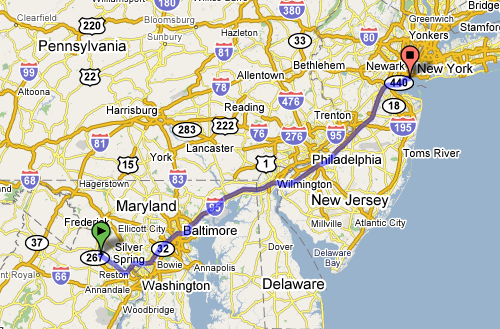Mobile Network vs. Mobile Device
This weekend we drove from our home in Leesburg, VA to visit my wife’s family in Staten Island, NY. Along the way, we passed through rural areas of Maryland, Delaware, and New Jersey. I had my laptop with me, which we used while we were driving. I used my Blackberry 8830 as a tethered modem, and we enjoyed UNINTERRUPTED high speed internet access.
Ubiquitous high speed access is a new experience for me. I’ve done this drive before with AT&T and T-Mobile, and the continuity of service is spotty in some areas, nonexistent in others. If I’d had an iPhone with me, I would have been SOL — no tethered modem, no WiFi to “hop” onto when the AT&T network was unavailable.
The New York Times is reporting today that a security firm has found a way to hack into an iPhone to steal personal data — one of the ways to exploit the security flaw is through WiFi.
As I write this, I’m sitting in Panera Bread enjoying free WiFi, ignoring the fact that my computer is probably hackable right now.
My point with all this? The iPhone is a breakthrough mobile device. My MacBook Pro is a fantastic, albeit somewhat less portable mobile device. But without the kind of secure, always-on high-speed Internet access that I enjoy while sitting at a desk, with a router plugged into the wall, these devices can only deliver a fraction of their value.
“Web 2.0″ has been driven by wide adoption of broadband access in homes and businesses. Now everyone’s looking to mobile for Web 3.0. But it’s simply not going to happen until high-speed Internet access is always on, plug-and-play, SECURE, and truly UBIQUITOUS, just like I enjoy at home on my encrypted WiFi network (although who knows how secure that really is).
Google knows this — that’s why it’s bidding $4.6 billion for the FTC auction of the old 700MHz wireless spectrum. The condition?
- Open applications: Consumers should be able to download and utilize any software applications, content, or services they desire;
- Open devices: Consumers should be able to utilize a handheld communications device with whatever wireless network they prefer;
- Open services: Third parties (resellers) should be able to acquire wireless services from a 700 MHz licensee on a wholesale basis, based on reasonably nondiscriminatory commercial terms; and
- Open networks: Third parties (like internet service providers) should be able to interconnect at any technically
feasible point in a 700 MHz licensee’s wireless network.
Google wants to make Internet access like the electrical outlet next to my table that I’m plugged into for free.
Until that day comes, mobile devices will be symbols of unrealized potential, waiting for the mobile network to catch up.
